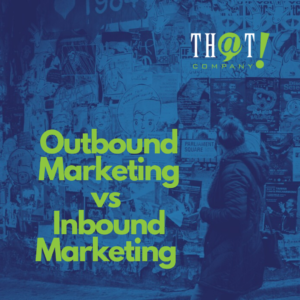Inbound and outbound marketing are important strategies for every business. According to Forbes.com, the average person is exposed to 4,000-10,000 advertising messages each and every day – everything from TV ads and outdoor signage to radio spots and digital ads all over the internet. So, what ads are going to make your target customers want to do business with you and what marketing strategies are best employed to get them into your marketing funnel?

Inbound and Outbound Marketing strategies are used by companies and merchants, as well as agencies hired by them, to get their message out to clients or customers that their product or service can satisfy a need or want. There are different tactics and tricks for each option and getting it right can make or break a business. Let’s take a detailed look at each solution so you know what is best for you, although most find a combination of each work the best.
What is Outbound Marketing?
Outbound leads are ones that you reach out to, usually print/TV/radio advertising, social media advertising, cold calling, direct mail, email blasts, and other methods that are sent to a large audience of people most of which may not even be looking for the product you are offering. They don’t know you yet, they haven’t seen your website, landing pages, or other materials. They haven’t signed up for a trial or a demo. They haven’t had any interaction with your brand and probably don’t even know you exist. They have not done any research on the product or services and have no expectations on what the product or service even does. You find them and hope to encourage them to interact with your content and then be interested enough to use your services or products.
Outbound Lead Generation Advantages:
- You can do your research and target the exact audience or market you want to make prospects more qualified.
- You have direct control over the amount of leads you want to generate.
- You can have multiple methods of attracting leads and managing them.
- You can potentially reach qualified prospects, often more quickly, than inbound leads.
Outbound Lead Generation Disadvantages: 
- You must have a large volume pool to work with.
- Costly and can take up a lot of your time.
- Typically takes multiple attempts to reach a prospect and maybe more to get them to interact.
- Prospects can be all over the buying cycle, so even when you contact them, they might not be able or ready to purchase, making the buying cycle even longer.
Many of the methods used for outbound marketing have been limited because of technology, requiring even more volume. The technology of acquiring these leads is getting better but is also attracting more competition.
The Problem with Outbound Marketing:
The big problem with traditional outbound marketing is that in order to be appropriate for the largest number of people, the message must be very general and not direct. In other words, it’s near impossible with traditional outbound marketing tactics to be relevant to a variety of specific needs and challenges limiting the ability to attract the required attention.
[bctt tweet=”The big problem with traditional outbound marketing is that in order to be appropriate for the largest number of people, the message must be very general and not direct.” username=”ThatCompanycom”]Outbound Marketing Facts:
- 91% of email users have unsubscribed from an email they previously opted into. Why? Most likely, the content wasn’t relevant to them or was being delivered to often.
- 86% of people skip TV ads. With the growing number of online TV streaming services and DVR capabilities, television ads can be fast-forwarded or skipped. You can’t make an impression on your audience if they’ve tuned you out!
- Digital music services and satellite radio make it too easy for listeners to avoid radio advertising. As of July 2018, there were 180 million active users on Spotify alone. Radio does not have the impact it once did.
- 44% of direct mail is never opened. Referred to as “junk mail” or “spam mail” this tactic has surprisingly low effectiveness
- The average banner ad click-thru rate is one-tenth of one percent. Not exactly a lot of bang for your buck and can deplete budgets fast if not kept in check.
- 84% of 25-34 year olds have left a website because of intrusive or annoying advertising. Including those “live chat” programs everyone seems to add to their site.
Pushing messages out isn’t as effective anymore because your audience has options and ways to avoid them. Marketers are faced with ever-increasing competition and hardships finding ways to reach out to their targeted audiences and customers. It takes professionals that keep up with the latest strategies and industry changes to be effective.
What is Inbound Marketing?
Inbound leads come to you. At the heart of inbound marketing is content: website content, blog content, sign up for a trial or a demo, or use downloadable (“advanced”) content offered on a website, like white papers, guides, tip sheets, and others. They not only acknowledge the existence of your brand but they also find you and decide they want to interact with your content, service, or products. They have an urgent need to fix a problem or are actively looking for a solution or product, which means they are more qualified and looking for answers in the form of content. When using an inbound approach, marketers develop this content to align with specific points in prospective buyers’ journeys:
 At the beginning of their journey, a buyer is getting familiar with the problem and potential solutions;
At the beginning of their journey, a buyer is getting familiar with the problem and potential solutions;
In the middle they’re comparing a small set of potential solutions;
And at the end of the journey, they’re doing due diligence needed to make a final decision.
There are topics and types of content that align nicely with each of these stages, and by creating and offering them whether, through your blog or advanced content, you’re satisfying information needs that the prospects have at all points in their journey. And, since that journey is largely conducted online (an overwhelming majority (89%) of B2B researchers use the internet in their research process and they conduct 12 searches on average prior to engaging on a specific brand’s site), they’ll find relevant content when doing searches.
Inbound Lead Generation Advantages:
- Prospects are further along the buying cycle than outbound leads, which means shorter time to conversion.
- Leads are coming to you, which means less time chasing leads and more time selling.
- Leads have at least some kind of idea of your product or service before you even talk with them.
- They are more likely to talk to you and accept your communications when you reach out to them, which equates to less time wasted on no shows and people ghosting you.
Inbound Lead Generation Disadvantages:
- Prospects are more likely to not be qualified or in your target market than outbound leads.
- Might just be price shopping to lower their own costs or to steal ideas or trade secrets.
- Still might require chasing despite being an inbound lead.
- Far fewer lead frequency than outbound leads, especially for smaller companies.
- It takes longer to implement than outbound. Lead growth could take months or years rather than days or weeks.
Facts About Inbound Marketing:
- Inbound marketing costs 62% less per lead than outbound marketing.

- Content marketing generates 3x as many leads per dollar than traditional outbound marketing and typically convert better.
- 57% of online users view content at least once per month and the average user spends 20% of their online time viewing content.
- 70% of people would rather learn about a company through content and research versus advertising.
- High quality, relevant and valuable information makes prospects more likely to take action and become a client or customer.
So, as you can see there are varying levels of marketing that are better suited differently based on several factors. Your industry, your longevity in the market, and status among your competitors are three important factors but that list of differentiators is endless. Talking with professionals can help assist this process and get you on the right track. Give us a call today to talk about the different marketing avenues your business has. 1-800-255-0396
Authorship: Marty C.
























